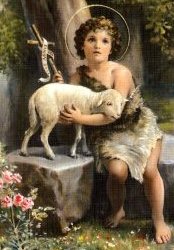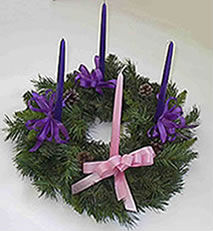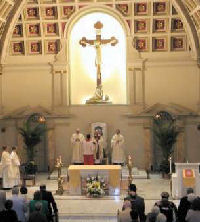Catholic Activity: What is Advent?

A short explanation of the Advent season and its significance in the Liturgical Year.
DIRECTIONS
The Coming of the Lord
Drop down dew ye heavens from above. Let the earth be opened and bud forth the Savior.
Happy New Year! While a month yet remains in the civil year, the Church is celebrating the beginning of a new Liturgical year with the First Sunday of Advent on November 27, 2011. Advent — from the Latin ad venio, “to come” — is the liturgical season anticipating the Adventus Domini, the "coming of the Lord.” While the days grow shorter and colder, we prepare for the “Sun of Justice” who comes to kindle our hearts with his light and his love.
The Eternal Word, who is outside of time, became Incarnate in time, thereby making all time sacred. In the season of Advent, we await the coming of Christ on all the levels which we experience time: in the past — as a babe in the stable of Bethlehem; in the present — as grace in our souls; and in the future — as the Judge at the end of time.
 The Advent season is filled with preparation and expectation. Everyone is getting ready for Christmas — shopping and decorating, baking and cleaning. Too often, however, we are so busy with the material preparations that we lose sight of the real reason for our activity: the Word made flesh coming to dwell among us. Christians are urged to preserve the spiritual focus of Christmas amidst the prevailingly secular and consumer-driven society.
The Advent season is filled with preparation and expectation. Everyone is getting ready for Christmas — shopping and decorating, baking and cleaning. Too often, however, we are so busy with the material preparations that we lose sight of the real reason for our activity: the Word made flesh coming to dwell among us. Christians are urged to preserve the spiritual focus of Christmas amidst the prevailingly secular and consumer-driven society.
In the midst of the hustle and bustle of the season, let us strive to keep Advent a season of waiting and longing, of conversion and hope, meditating often on the incredible love and humility of our God in taking on flesh of the Virgin Mary. In our shopping and baking, let us remember to purchase and prepare something for the poor. When we clean our homes, let us distribute some of our possessions to those who lack many necessities. While we are decking the halls of our homes, let us not forget to prepare a peaceful place in our hearts wherein our Savior may come to dwell.
Focus on the Liturgy
I am the voice of one crying in the wilderness, make straight the way of the Lord.
 There are always four Sundays in Advent, though not necessarily four full weeks. The liturgical color of the season is violet or purple, except on the Third Sunday of Advent, called Gaudete or Rejoice Sunday, when optional rose vestments may be worn. The Gloria is not recited during Advent liturgies, but the Alleluia is retained.
There are always four Sundays in Advent, though not necessarily four full weeks. The liturgical color of the season is violet or purple, except on the Third Sunday of Advent, called Gaudete or Rejoice Sunday, when optional rose vestments may be worn. The Gloria is not recited during Advent liturgies, but the Alleluia is retained.
The prophecies of Isaiah are read often during the Advent season, but all of the readings of Advent focus on the key figures of the Old and New Testaments who were prepared and chosen by God to make the Incarnation possible: the Blessed Virgin Mary, St. John the Baptist, St. Joseph, Sts. Elizabeth and Zechariah. The expectancy heightens from December 17 to December 24 when the Liturgy resounds with the seven magnificent Messianic titles of the O Antiphons.
The Advent season also has a Marian and pro-life focus. We meditate on this wonderful mystery of the Word Made Flesh with as much eagerness as his Mother, Mary prepared and awaited the birth of her son. In the USA we celebrate the special feasts of the Immaculate Conception, the patroness of the United States of America, on December 8, and Our Lady of Guadalupe, patroness of the Americas, on December 12. Other saints’ days traditionally associated in with our preparation for Christmas include St. Nicholas, patron saint of children whose feast falls on December 6, and the saint of light, St. Lucy on December 13.
Activity Source: Original Text (JGM) by Jennifer Gregory Miller, © Copyright 2003-2023 by Jennifer Gregory Miller







